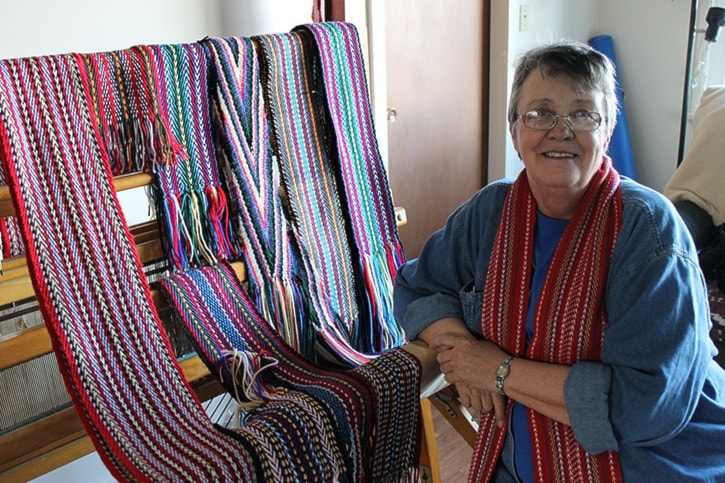Nanaimo’s Val Beauchamp tucks a blue-threaded shuttle under a rainbow of coloured strings stretched tight across her loom and pulls, the beginnings of a pattern taking shape.
“I can do this for hours,” she said, her south-Nanaimo apartment filling with the sound of wood knocking on wood as she flips the looms’ levers to create a Métis sash for the lapel, a miniature symbol of pride and identity.
Beauchamp, 66, is the only known weaver in the Harbour City that creates Métis sashes, some of which have been commissioned by Vancouver Island University as gifts for its graduating Métis students.
The sash is part of the Métis tradition. It’s usually worn for special occasions, but at one time it was a multi-purpose tool for people who could use it as a belt, sling or a marker during a buffalo hunt.
Each colour woven into the sash has a meaning, from yellow for prosperity to green for fertility and black for the dark times the Métis experienced.
Beauchamp said there are no rules on which colours are used – it’s whatever is felt in the heart.
Beauchamp added orange into one sash, for example, instead of the prosperity yellow for a Mi’kmaq man because she said the Mi’kmaq make their living hunting lobsters.
Beauchamp is seldom without a sash because she’ll tell you it’s who she is. She found out she was Métis thanks to a genealogy search and now surrounds herself with symbols of her European-First Nation ancestry, from buffalo horns that hang on her wall, to drums and a coat rack draped with sashes.
She began to finger weave more than four years ago when a store-bought sash fell apart on her and she decided to try making her own. But she prefers the loom, which allows her to make a sash in a matter of days.
She has five, but only two looms are intact. The largest, which takes up most of her living room, she got in pieces and rebuilt. She taught herself how to use it.
For her, weaving is relaxing, like getting a massage.
“I zone out. I’m not here, I am in that sash and every time I think about it, I think about the meanings in it and what the person is going to feel like wearing it,” she said, focused in that moment on demonstrating a smaller table loom.
The university started a new practice last year, on the advice of elders, of giving a gift to aboriginal students graduating from a Red Seal trades program or with a degree. The Coast Salish get blanketed, and the Métis students get a sash that Beauchamp designed specifically to represent the university. She personally presented the first two she created to VIU students.
It’s not that the sashes are hers that she likes most about graduates wearing them; it’s that they are showing their identity, who they are – that they’re Métis.
“They are presented at the aboriginal graduation so the other First Nations get all their gifts and when our Métis kids get ours they can stand up there and say, yeah, I’m Métis, this is who I am,” she said. “That’s what I like.”
Stella Johnson, VIU’s Métis elder, said students get certificates but this is something extra and has never been done before. The art of making sashes on the loom is pretty well lost, not many can do it and it takes a lot of time, said Johnson, who finds Beauchamp’s “awesome.”
“They are even more special, personally made by someone,” she said.
